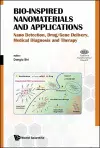
Bio-inspired Nanomaterials And Applications: Nano Detection, Drug/gene Delivery, Medical Diagnosis And Therapy
Donglu Shi - Hardback
£90.00
Dr. Julian Wang is an Associate Professor and Graduate Program Officer in the Department of Architectural Engineering at Pennsylvania State University, U.S. He also has affiliated appointment with the Department of Architecture and Materials Research Institute at Penn State. He received his Ph.D. from Texas A&M University in 2014 and Doctor of Engineering from Tianjin University, China in 2011. Before joining Penn State University, he has previously worked at the University of Cincinnati, Tsinghua University, and Lawrence Berkeley National Laboratory. He has been continuously involved in the research on sustainable building engineering and design, focusing on the fundamental topics of thermal and optical behaviors of building façades (especially windows and glazing systems) and the design integration of emerging functional materials for building energy efficiency, environmental sustainability, and indoor visual and thermal comfort, health, and well-being. He is also a recipient of the National Science Foundation CAREER Award and Illuminating Engineering Society Richard Kelly Award. He currently serves as Associate Editor of the journal of TAD (Technology, Architecture, and Design) published by Association of Collegiate Schools of Architecture and Taylor & Francis, and the Chairperson of the Solar Buildings Division in the American Solar Energy Society.
Dr. Donglu Shi is currently the Chair and Graduate Director of the Materials Science and Engineering Program in the Department of Mechanical and Materials Engineering, College of Engineering and Applied Science, University of Cincinnati, U.S. Dr. Shi’s research focuses on design and development of new nanostructures for novel properties and applications in energy and environment. These include National Science Foundation funded research in spectral selective solar harvest and energy generation via bio-inspired transparent thin films, photothermal-photovoltaic dual modality smart building skins, and optical thermal insulation by porphyrin-based photothermal coatings. His research interests also include developing green nanobiohybrids for an advanced living system that is energy neutral, zero emission, and climate positive with environmental resilient and biosafety. Dr. Donglu Shi has published 300 peer-reviewed journal papers including ones in Nature, Physical Review Letters, Advanced Materials, Biomaterials, and ACS Nano. Donglu Shi has been elected as a Graduate Fellow at the University of Cincinnati. He has received the SIGMA XI Research Recognition Award, Distinguished Researcher Award, and Neil Wandmecher Teaching Award. He is a Fellow of American Society for Materials International and Editor-in-Chief of Nano LIFE.
Dr. Song is currently the Director of Building & Technology Research Institute and Tenue Professor at School of Architecture, Tsinghua University. He is also National First Class Registered Architect, Deputy Chief Architect of THAD (Architectural Design & Research Institute of Tsinghua University Co., LTD), and Co-founder and Principal Architect of SUP Atelier. He has been working as a visiting scholar at Technology University of Munich. Dr. Song’s main research is about sustainable building design theory and method, sustainable urban design and research, and technology integration in architecture. Dr. Song’s practice portfolio includes many high-profile projects such as Chang Shu Library, Deyang Surface Engineering Research Institute, Post 512 Earthquake Reconstruction of Tumen Primary School and Nursery, Waterfowl Pavilion of Beijing Zoo, Central Canteen & Student Center of Tsinghua University, and THE-Studio (Tsinghua Eco Studio). He has also received many national and international awards including ARCASIA awards. Dr. Song serves as a Secretary-general of the Green Building’s Theoretical and Practical Group of Chinese Green Building Committee, Deputy Director of the Committee of Architectural Technology in the National Steering Committee of Architectural Education, and Deputy Director of Active House Academic Committee of Architectural Society of China.